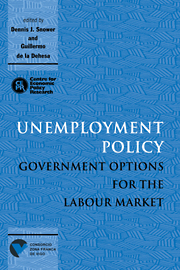Book contents
- Frontmatter
- Contents
- List of figures
- List of tables
- Preface
- Acknowledgements
- List of conference participants
- 1 Introduction
- PART ONE GENERAL POLICY ISSUES
- PART TWO DEMAND MANAGEMENT AND SUPPLY-SIDE POLICY
- PART THREE SUBSIDISING EMPLOYMENT AND TRAINING
- PART FOUR LABOUR MARKET REGULATIONS
- PART FIVE POLICY, JOB REALLOCATION AND THE UNEMPLOYMENT–PRODUCTIVITY RELATION
- PART SIX COMPARING UNEMPLOYMENT POLICIES
- 16 Unemployment in the OECD and its remedies
- Discussion
- Discussion
- 17 The unemployment and welfare effects of labour market policy: a comparison of the USA and the UK
- Discussion
- Discussion
- Index
17 - The unemployment and welfare effects of labour market policy: a comparison of the USA and the UK
Published online by Cambridge University Press: 07 September 2010
- Frontmatter
- Contents
- List of figures
- List of tables
- Preface
- Acknowledgements
- List of conference participants
- 1 Introduction
- PART ONE GENERAL POLICY ISSUES
- PART TWO DEMAND MANAGEMENT AND SUPPLY-SIDE POLICY
- PART THREE SUBSIDISING EMPLOYMENT AND TRAINING
- PART FOUR LABOUR MARKET REGULATIONS
- PART FIVE POLICY, JOB REALLOCATION AND THE UNEMPLOYMENT–PRODUCTIVITY RELATION
- PART SIX COMPARING UNEMPLOYMENT POLICIES
- 16 Unemployment in the OECD and its remedies
- Discussion
- Discussion
- 17 The unemployment and welfare effects of labour market policy: a comparison of the USA and the UK
- Discussion
- Discussion
- Index
Summary
A presumption that natural rates of unemployment are excessive is common, particularly in the economies of Europe. Two culprits are typically identified in the literature, labour market policies intended to compensate for lost earnings and excessive market power in the hands of employed worker ‘insiders’. According to Layard, Nickell and Jackman (1991), 91 per cent of the variation in unemployment rate averages over the 1983–8 time period across the principal 19 OECD industrial countries can be explained by variation in the liberality of unemployment insurance (UI) benefits, the extent of collective bargaining coverage, the degree of coordination in the wage determination process, and emphasis on active labour market policies. Although the authors recognise that unemployment rate differentials do not necessarily reflect differences in economic welfare, they argue that the effects of UI and labour bargaining powers are likely to yield ‘too much’ unemployment, particularly in Europe. Hence, their recommendations for the UK include a limitation on the duration of UI benefits, a strong ‘willingness to work’ test as a condition for the receipt of benefits, and an active labour market policy focused on those expected to have long unemployment spells. Active policies include adult training, recruiting subsidies, public employment as the ‘employer of last resort’ and wage subsidies.
The purpose of this chapter is to conduct computational experiments that reveal the quantitative implications of a particular labour market equilibrium model, that developed by Mortensen and Pissarides (1994), for the unemployment and welfare effects of existing labour market policy and possibly policy reforms.
- Type
- Chapter
- Information
- Unemployment PolicyGovernment Options for the Labour Market, pp. 545 - 572Publisher: Cambridge University PressPrint publication year: 1997
- 36
- Cited by



